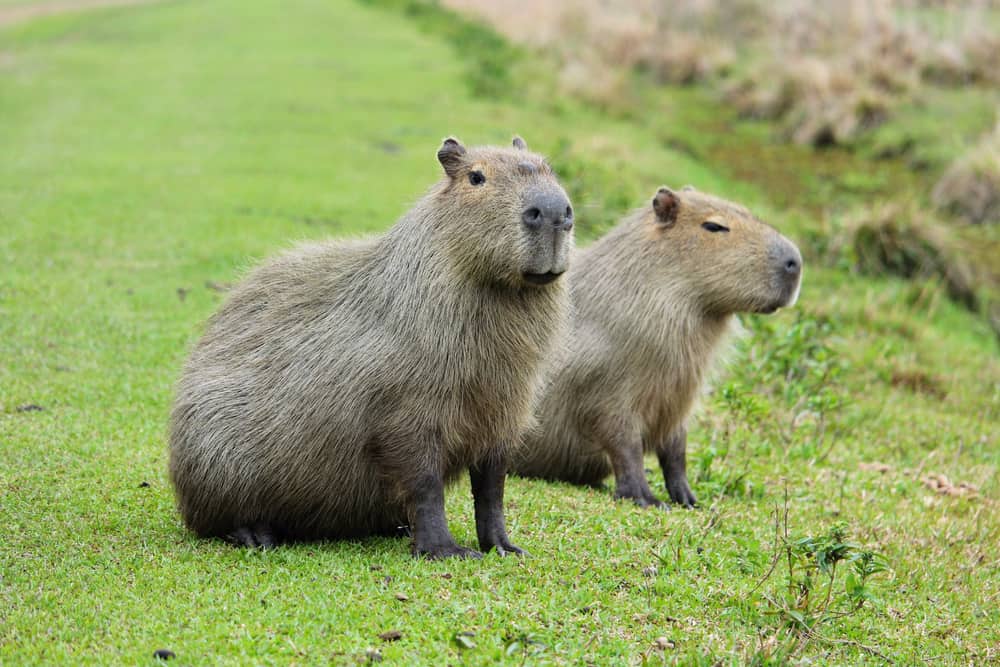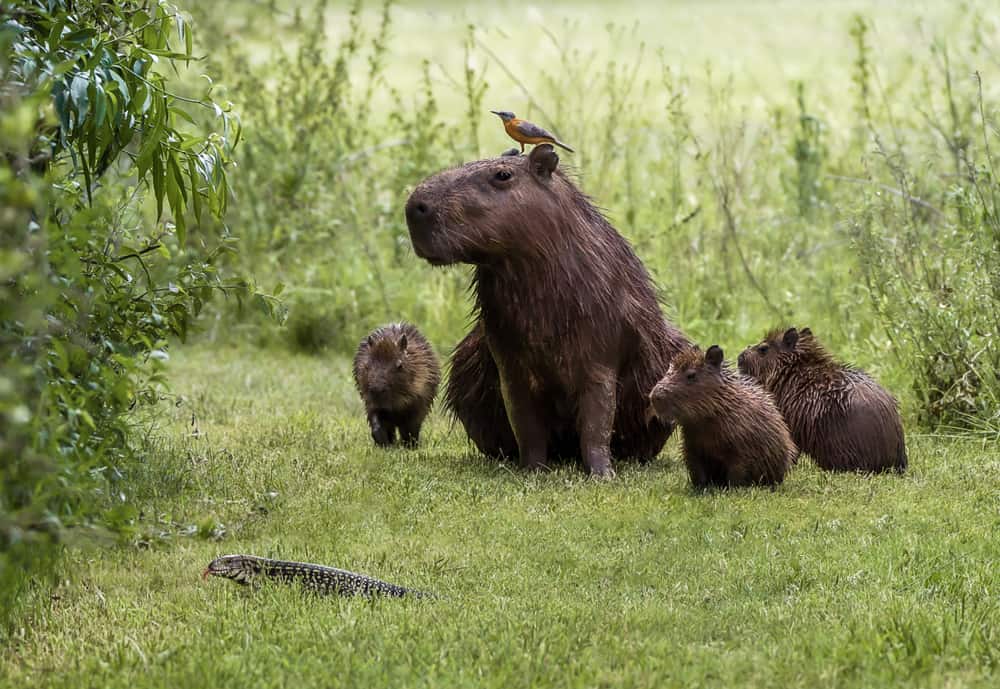Ever bumped into an unusually large rodent that looks like a shaggy-haired pig without a snout or a beaver without a tail and wondered what it was? That was a capybara! And if you are like us, chances are you would want to know, “What do capybaras eat?” Well, keep reading!
Capybara Habits and Biology
Capybaras are the largest rodents in the world. However, they don’t look like most of the rodents you run into in the alleyways. They are huge and some can even be as large as coyotes. Their feet are webbed, and unlike typical rodents, capybaras lack a tail. Their face is also not wedge-shaped like those of most rodents. They look much more like giant guinea pigs.
These water-loving rodents can grow anywhere between 40 and 50 inches long and up to 20 inches tall. Depending on the gender, their weight can range between 60 and 170 pounds, with females being a little heavier than males.
You will find capybaras in areas where there are plenty of water sources, as they need to always keep their dry skin wet. Some of their habitats include marshes, riverbanks, estuaries, and river streams. They spend most of their time in the thick vegetation of these areas keeping cool and hiding from predators. Some people will, therefore, refer to them as water hogs.
When it comes to their interaction with others, capybaras are social animals, and will often be found in groups of around 10 members. In wet seasons, however, the groups will have around 35 members each, but when it gets hot, this number can shoot up to 90 members.
Each group has a dominant male that leads it, and depending on size, a single group can cover over 200 acres of land.
Capybaras will mostly be active during the early morning and evening hours. But when they are in distress or in places where they sense danger, they will become nocturnal. The dark hides them from predators while they feed and socialize.
Gestation in capybaras lasts about 4 months, and females will give birth to between 1 and 7 pups at a time. But on average, capybaras often reproduce around 3 young ones at once.
The pups stay in their parents’ groups for about 1 year after which they leave to find new ones. The males become sexually active at around 15 to 24 months while females only take 7 to 12 months. On average, capybaras live for 6 to 10 years.
What Do Capybaras Eat in the Wild?
Because capys are rodents, one of their most well-known features is the ever-growing front teeth. These critters use these long, sharp teeth to cut through plants found near and around water bodies.
An adult capybara can eat up to 8 pounds of vegetation per day. During summer when there are no water plants to feed on, capybaras’ diet mainly consists of grains, fruits, and other foods that grow on land.
These animals have also been found to eat their own poop! The bacteria in their droppings help digest the thick fiber present in their meals. The process is called coprophagy, and not only does it help breakdown fiber but also allows them to ingest proteins and other nutrients in higher numbers.
Watch this video of capybaras fiercely gnawing on a pumpkin to see how these rodents eat their food:
What Do Capybaras Like to Eat?
Capybaras are herbivores and will primarily feed on:
- Water plants and grasses
- Grain
- Melons
- Pumpkin
- Squash
- Reeds
- Bark
How Capybaras’ Diet Benefits the Ecosystem
With capybaras’ source of food being majorly vegetation, they help minimize the growth of invasive plants. Such vegetation has plenty of negative effects on our environment. For starters, it lowers the quality of the nutrients in the soil, affects water availability, and generally changes the conditions of the environment they are in. This affects both the quality and availability of food.
Some of the vegetation that capybaras feed on may be invading the area, and by hindering the growth of these plants, the original quality of soil is maintained, which gives native plants a better chance to grow because the environmental conditions in the area remain intact.
Apart from bringing down the population of unwanted plants, capybaras also help with the growth of healthy plants. The droppings from the foods that these critters eat are rich in nutrients that make the soil fertile for vegetation growth.
Facts About Capybaras
1. Capybaras Have Unique Vocalizations
Capybaras make many different sounds to communicate with other members of their family. They will squeal, chatter their teeth, whistle, whine, cry, click, or bark to signal a move, warn others of danger, or keep track of their cubs. The young ones are particularly vocal and will make sounds almost constantly.
2. Capybaras Can Sleep in Water
One of the most interesting things about the capybaras is their ability to fall asleep in the water. They can dive and stay hidden underwater for close to five minutes. If they want to nap, they will just move to the edge of the waterbody and lift their nose above water. Sleeping along mangroves, marshes, and rivers helps keep these creatures cool.
3. Capybaras Are Excellent Swimmers
The reason why most capybaras are found near water bodies is that they are semi-aquatic animals. Banks of rivers often pose many dangers to capybaras, but these are still the perfect areas for these creatures to live because they are able to quickly escape from predators like eagles, wild cats, and anacondas.
Their webbed feet enable them to seamlessly swim in the water. Most features of their face are also located near the top of their heads so they can see and breathe properly while they swim.
Check out this video of a capybara skillfully swimming underwater:
4. Capybaras Teeth Do Not Stop Growing
Like all rodents, capybaras have two, long teeth in the front that grows continuously. To wear these teeth down and prevent them from growing to an unreasonable length, capybaras must keep grinding and chewing on food.
Their molars never stop growing either, but they keep them at the appropriate lengths by constantly grinding food.
5. Capybaras Are Nature’s Ottoman
Literally! Many animals like to sit and ride on their back. Capybaras don’t ever seem to deny another animal’s request to sit on their backs. You will see a whole host of birds, rabbits, monkeys, and even fellow capybaras laying, perched, or seated on the back of these obliging animals.
6. Capybaras Live a Social Life
Capybaras are not loners. They love others’ company, hence you will see them in groups of around 10 to 20 members, sometimes even 100 individuals. Living in groups helps them protect their habitat.
Female capybaras raise their young ones together and cubs can nurse from different moms. The group also watches over the young ones because they are more vulnerable to predation.
7. A Mature Capybara Can Weigh as Heavy as an Adult Human
As mentioned earlier, capybaras are the largest rodents in the world, with adults sometimes weighing up to 170 pounds. Females are heavier but males can also weigh pretty heavy, with some weighing up to 150 pounds.
8. Capybaras Eat Their Own Poop
To get all the nutrients of their every meal, capybaras don’t just eat vegetation; they eat even their own poop. They do this mostly in the morning and the practice provides them with the bacteria that aid with the digestion of the food they eat.
Because some of the foods they munch on are too hard to digest, eating feces gives their bodies another opportunity to absorb nutrients from the previous day’s meal.
9. Capybaras Run Pretty Fast
While they are known to spend most of their lives by the edges of water bodies, capybaras know their way around the dry land as well and are actually quite agile. Capybaras have been found to run at speeds of up to 21 mph. That is almost as fast as a horse runs.
10. Predators Determine When Capybaras Will Be Active
While capybaras will mostly be active at dawn or dusk, their activity will often be affected by the presence of predators in the area. If they are in a habitat that has pumas, jaguars, or black vultures, for instance, capybaras will prefer to feed and socialize at night so the dark can cover them from these predators.
11. The dominant Male Enjoys More Benefits Than Other Members of the Group
One of the benefits is that he remains at the center of the group at all times, which gives him added protection against predators. He also gets to mate with all the female capybaras in the group.
Summary
Capybaras, like other rodents, survive on a plant-based diet. Their food mostly comes from aquatic plants and grasses, although they sometimes feed on grain, melons, bark, and other plant foods they find on dry land. Capybaras eat their own waste too, a practice that helps them ingest more nutrients.


capybaras are religon
capybara likes huge giant balls
yes like big giant balls